Mapping Israel-Lebanon cross-border attacks
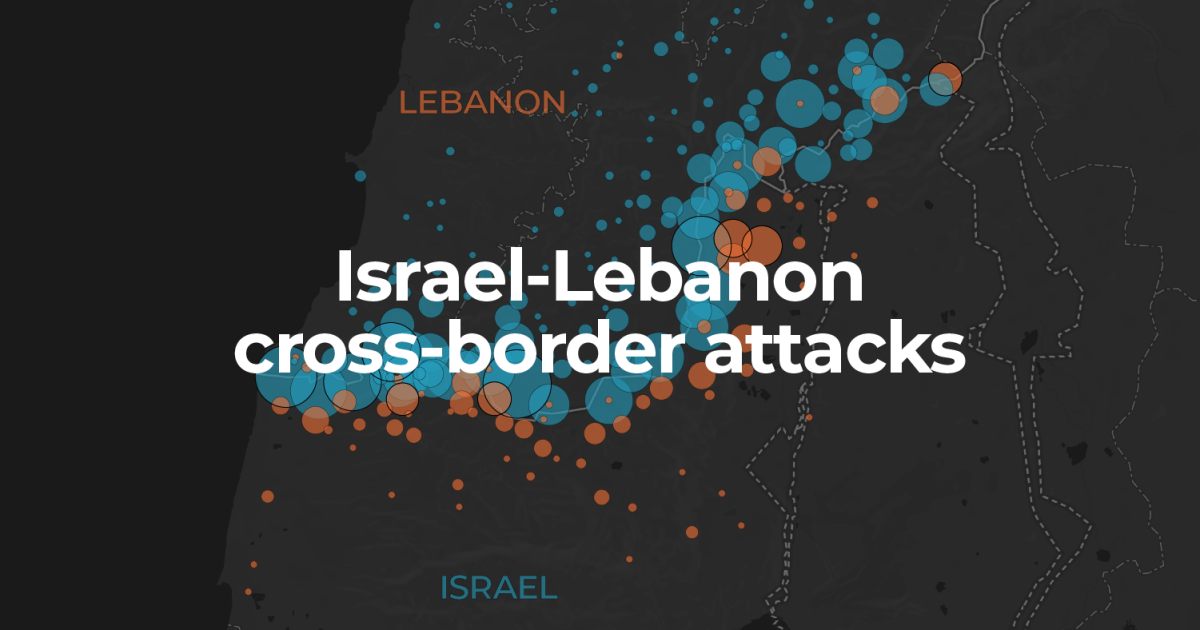
As Israel continues its war on Gaza into a seventh month, about two hours north, it has been fighting a parallel war along the border with Lebanon that threatens a wider regional conflict.
Since October 8, when Hezbollah – a Lebanese Iran-backed Shia armed group and political party – launched attacks on Israel in solidarity with the Palestinian people, Israel has attacked it nearly 4,000 times along the 120km (75-mile) border.
Hezbollah formed in 1982 to fight Israel’s invasion and occupation of southern Lebanon. In 2006, the group fought a 34-day war widely regarded as a strategic and military failure for Israel.
Hezbollah chief Hassan Nasrallah has stopped short of declaring an all-out war against Israel but said his forces are not afraid of getting involved in one.
Hezbollah says its military operations against Israel will continue until the Israeli assault on Gaza stops. In response, Israeli leaders vowed to remove Hezbollah from Lebanon’s south, even if by force.
The attacks
According to the Armed Conflict Location and Event Data Project (ACLED), Israel, Hezbollah and other armed groups in Lebanon exchanged at least 4,733 attacks across the border from October 7, 2023 to March 15, 2024.
Israel conducted about 83 percent of these attacks, totalling 3,952 incidents, while Hezbollah and other armed groups were responsible for 781 attacks.
About 65 percent of all attacks were artillery or missile attacks, 25 percent were air or drone strikes, and the remaining 10 percent were armed clashes, destruction of property, remote explosives or improvised explosive device (IEDs).
In addition to Hezbollah – which bore the brunt of the hostilities – other notable forces involved in attacks against Israel include the Lebanese al-Fajr Forces and Amal Movement, as well as Hamas’s Qassam Brigades and Islamic Jihad’s al-Quds Brigades, both armed wings of Palestinian groups that maintain a presence in Lebanon.
Israel has attacked these locations in southern Lebanon the most:
- Aita al-Shaab – 190
- Ras al-Naqoura – 154
- Houla – 143
- Tayr Harfa – 139
- Alma ash-Shaab – 134
Groups from Lebanon attacked these locations in northern Israel the most:
- Kiryat Shmona – 62
- Margaliyot – 56
- Shetula – 43
- Shebaa Farms – 43
- Aramsha – 39
Timeline of attacks
Israeli jets and drones have struck targets across Lebanon as well as in neighbouring Syria with impunity for months.
In the last six months, Hezbollah and other armed groups averaged five attacks on Israel a day while Israel has conducted five times as many, about 25 attacks on Lebanon a day, according to ACLED.
ACLED also recorded at least 137 Hezbollah missile interceptions by Israel and eight interceptions of Israeli drones or missiles by Hezbollah.
On October 12, the Israeli military announced that a reserve soldier had been killed in a Hezbollah antitank guided missile attack.
The next day, on October 13, Israeli forces killed Reuters journalist Issam Abdallah and wounded six other reporters, including two from Al Jazeera, while they were filming cross-border shelling.
A UN probe found that Israeli soldiers had fired two 120mm rounds from a Merkava tank at the group of “clearly identifiable journalists” in violation of international law.
On November 24, a weeklong truce in Gaza took effect. During this time, ACLED registered at least nine attacks by Israel on Lebanon with no attacks recorded from the Lebanese side.
On January 2, a suspected Israeli drone strike killed Saleh al-Arouri, deputy political leader of Hamas, in Beirut along with six others.
The assassination of al-Arouri seemed to cause a shift in Hezbollah’s approach as it targeted the Meron air control base with 62 missiles of various types, on January 6.
On February 26, Israeli jets carried out three air strikes on Buday village near Baalbek, a Hezbollah stronghold in the Bekaa Valley – the first time Israel struck eastern Lebanon since October 7.
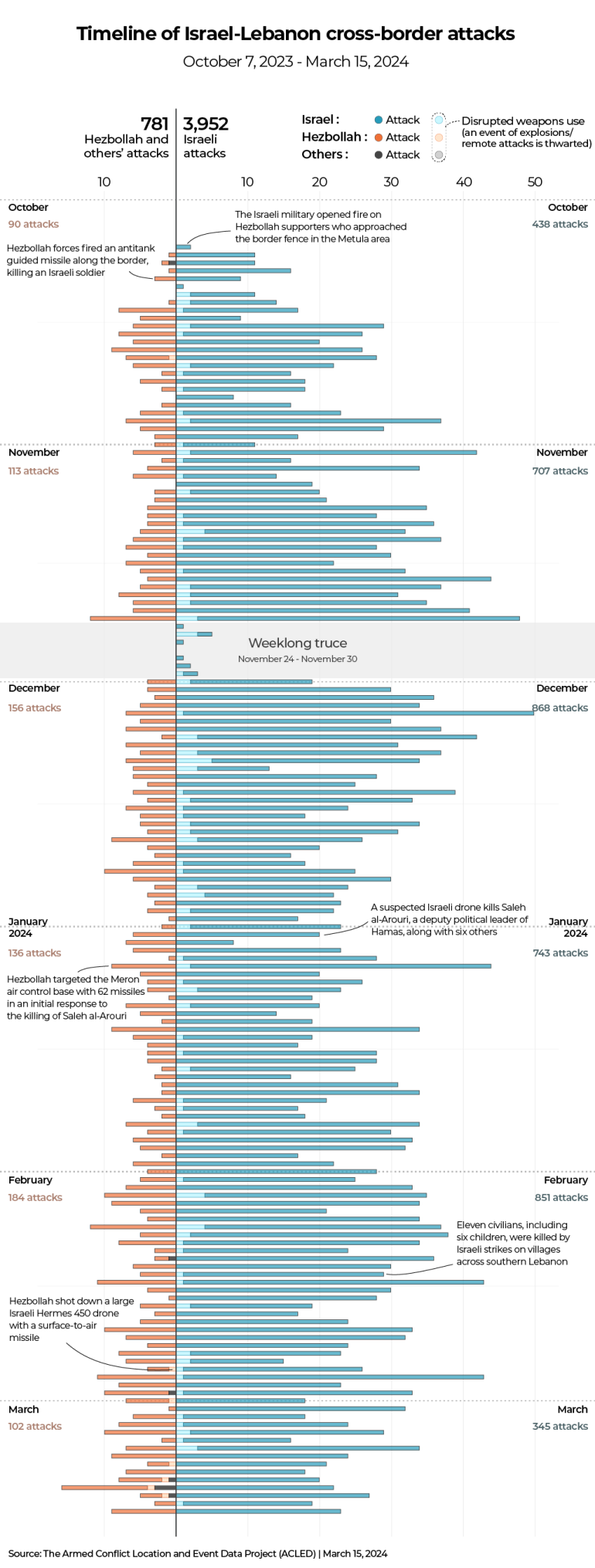
368 people killed
Using local media reports and statements from Hezbollah and other armed groups, Al Jazeera compiled a list of 368 people killed in Israeli attacks on Lebanon from October 8 to March 31.
Israeli strikes have killed at least 295 fighters from Hezbollah and other armed groups in Lebanon in the last six months, as well as about 73 civilians, including children, medics and journalists.
On February 14, two Israeli air strikes targeting towns in southern Lebanon killed at least 10 civilians including seven members of the same family, one of whom was a child.
Hezbollah’s rocket fire has killed around a dozen Israeli soldiers and half as many civilians.
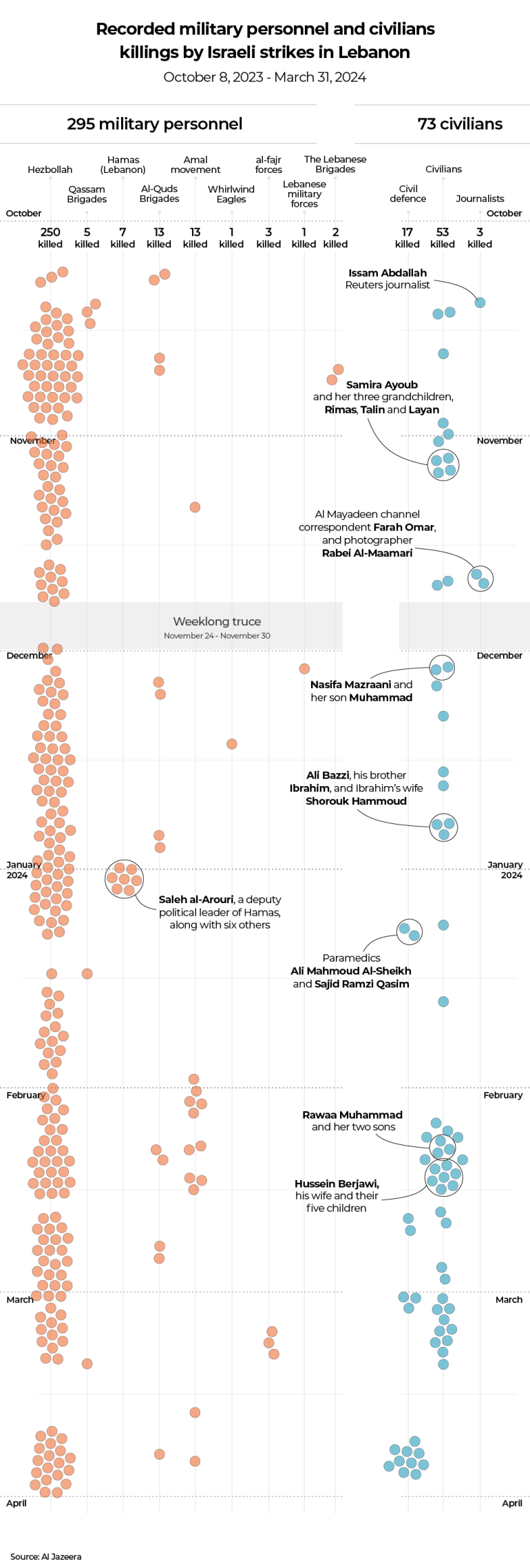
Tens of thousands displaced
According to the International Organization for Migration (IOM), more than 90,000 people have been displaced by the fighting in southern Lebanon.
The vast majority (96 percent) of those displaced come from three areas along Lebanon’s southern border: 71 percent from Bint Jbeil, 14 percent from Marjayoun, and 11 percent from Tyre.
According to estimates by the Southern Government Council, some 700 housing units were destroyed and more than 10,000 damaged by Israeli attacks, especially in Dhayra and Blida. In addition, Israeli attacks destroyed dozens of vehicles as well as water, electricity and communications infrastructure.
On the Israeli side, residents of 28 towns and villages within 2km (1.2 miles) of the border were told to evacuate.

Israel’s arsenal
Israel holds the most advanced missiles in the Middle East, many of which it produces domestically but most of its precision-guided missiles are from the United States.
According to the Center for Strategic and International Studies (CSIS), much of Israel’s capabilities are short-range tactical systems including the Popeye, Extra and Gabriel missiles.
Among Israel’s long-range missiles are its Jericho 2 and Jericho 3 ballistic missiles with a range of 1,500-3,500km and 4,800-6,500km respectively.
Also, despite not officially acknowledging it, Israel is believed to possess at least 90 nuclear weapons.

To confront incoming rockets and missiles, Israel uses three integrated air defence systems: the Iron Dome (short-range), David’s Sling (medium-range) and Arrow (long-range).
The Iron Dome was originally billed as providing city-sized coverage against rockets with ranges of between 4 and 70km (2.5 to 43 miles), but experts say this has been expanded.
David’s Sling, produced by Israeli weapons giant Rafael, can intercept rockets and missiles with a range of 40-300km (25-186 miles) while the Arrow, led by the Arrow 3 interceptor, has an estimated flyout range of up to 2,400km (1,491 miles).
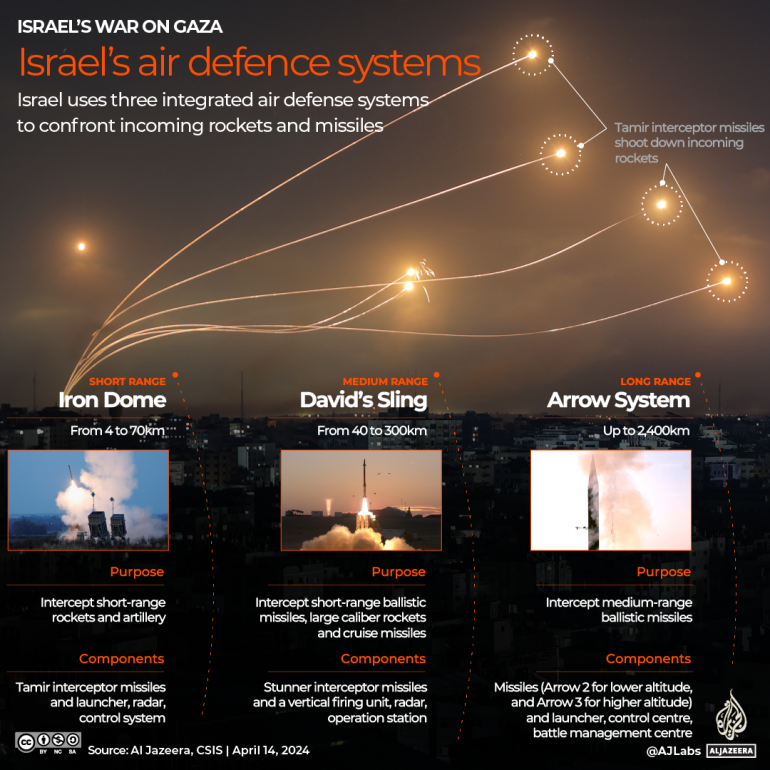
Hezbollah’s arsenal
Hezbollah is considered to be one of the world’s most heavily armed non-state actors with a rocket arsenal estimated to contain 130,000 pieces according to CSIS.
On October 19, Israel’s Institute for National Security Research published estimates of Hezbollah’s arsenal of missiles and drones.
Hezbollah, it said, had 40,000 grad-type missiles, with a short range of 15-20km (9-12 miles).
A step up is the 80,000 longer-range missiles including the Fajr 3 and Fajr 5 ballistic missiles, with a range of 100km (62 miles).
Finally, there are about 30,000 Zelzal or Fateh-110 missiles with a range of 200-300km (124-186 miles) – the longest-ranged weapons in Hezbollah’s inventory capable of reaching southern Israel.
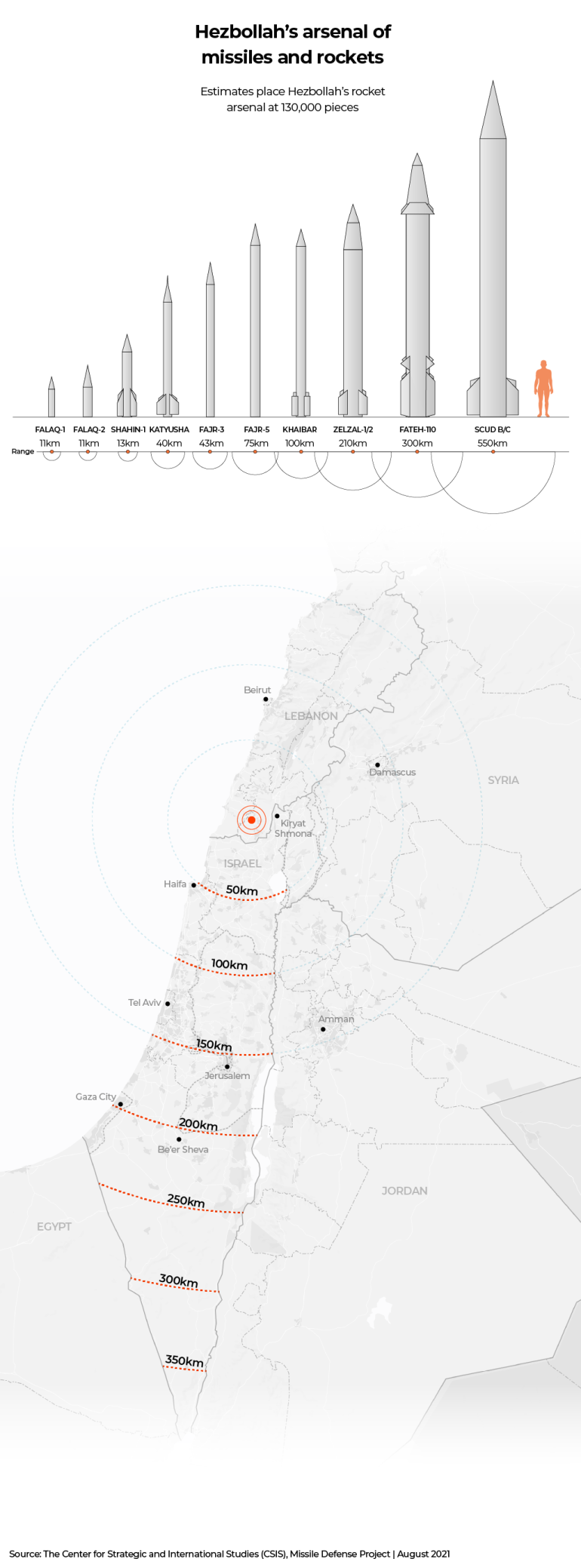
Related
Ashghal commences roads, infrastructure development in Birkat Al Awamer
Doha, Qatar: The Public Works Authority 'Ashghal' started the implementation of the Roads and Infrastructure Development Project in Birkat Al Awamer. T
India-Qatar trade agreement must be approached with caution: GTRI –…
India should tread cautiously on a potential free trade agreement (FTA
Qatar’s Ashgal likely to award industrial areas infra consultancy contract…
Qatar’s Public Works Authority (Ashghal) is expected to award the design and lead consultancy contract for the North of New Industrial Area Roads and Inf
Qatar’s $2.5bn green bonds fund enhances renewable energy and infrastructure
Doha, Qatar: Qatar continues to boost its investments in sustainable development, demonstrating its competitiveness on the global stage. An official no












